Yachting Monthly
- Digital edition


Expert advice: sailing instruments
- Katy Stickland
- October 4, 2022
Yachting Monthly's expert panel of cruisers gather their top tips and expert advice when it comes to using and understanding sailing instruments

Sailing instruments are a key part of our boating experience and have been since before the invention of the chronometer.
But there is no denying that as technology evolves sailing instrumentation has become ever more helpful and wide spread.
Here, our panel of expert cruisers gather some of their best advice on using sailing instrumentation to your advantage.
Makeshift mobile phone mast – Pete Goss

Wrap up a mobile to create your own phone mast. Credit: Pete Goss
We always carry a small waterproof bag for when we are tucked away in a safe, sheltered anchorage as a big weather system vents its spleen.
Unfortunately, these wonderful bolt holes are often mobile phone black spots, and so cut out all the wonderfully detailed weather than only a mobile phone can access.
I know we have the shipping forecast but sometimes I feel that a bit more detail is required before breaking cover.
Using on of our phones as a mobile hotspot in our waterproof bag at the top of the mast often find the elusive signal, which also means we can let family and friends know we are OK.
Checking GPS position – Dag Pike

If your depth readout doesn’t match the chart then you should check your GPS position. Credit: Dag Pike
These days you tend to trust GPS positions implicitly.
It will pinpoint your position and the sounder can show the depth.
If the sounder depth does not match that shown on the chart then take this as a warning sign.
GPS jamming means there will be no position and depending on your GPS you may not be aware of this. Spoofing can be another problem.
This could be the time to rediscover those long lost skills of position fixing without GPS.
Generating power afloat – Tony Curphey

Having a generator for backup is a good idea if sailing further afield. Credit: Tony Curphey
Roughly 95% of electrical power on my Nicholson 32, Nicola Deux is from her twin 125 Watt solar panels.
The main engine is also a source of charging but I don’t like to use it for that purpose, although I do run the engine for an hour or so every week or two at sea to keep it oiled, dry and supple.
As they say, use it or lose it. If that hour or so coincides with a drop of calm weather, then so much the better.
However, for backup I have a small Honda 1kW generator which has been onboard for several years.
Nicky was equipped with a 240v ring main system when I bought her, and a smart charger.
Start the genny, plug in the mains power lead and switch on the smart charger and all the batteries are fully charged within an hour or so.
Several times in the Southern Ocean, I’ve had periods of a week or more with cloud too heavy to activate the solar panels.
The generator only sips petrol in the most frugal manner and stores easily in the saloon.
Check the depth setting – Oliver Perkins

Ensure you know where the depth reads from. Credit: Oliver Perkins
When updating our navigation systems, a professional reset our depth sounder to read off the waterline, instead of beneath the keel.
A crew member, unaware of the change, led us straight onto the mud up a shallow channel, confident we still had a metre below us.
To avoid this, I’ll now ensure all crew are aware of where the sounder reads from.
In addition, we discovered that the sounder had been set to under-read the depth by 30cm.
This measuring mismatch is especially common on charter boats, where companies are cautious to avoid groundings.
Know your systems – Oliver Perkins

Take the time to understand how electronic gear, like your chartplotter, works so you can concentrate on helming. Credit: Oliver Perkins
Make sure you know your way around the boat’s electronics, especially complicated equipment like a chartplotter.
Recently I unexpectedly had to enter an unfamiliar harbour in the dark. I was navigating using a chartplotter in the cockpit, but couldn’t work out how to turn the brightness down.
This meant I couldn’t see where I was going and spent half the time distracted trying to change the setting.
Fortunately my crew could guide us in, but shorthanded I would have been going in blind.
I’d suggest thoroughly understanding your chartplotter especially brightness, chart detail levels and most importantly MOB settings.
There is little point in having the kit if you can’t work out how to use it when you are really relying on it.
Enjoyed reading this?
A subscription to Yachting Monthly magazine costs around 40% less than the cover price .
Print and digital editions are available through Magazines Direct – where you can also find the latest deals .
YM is packed with information to help you get the most from your time on the water.
- Take your seamanship to the next level with tips, advice and skills from our experts
- Impartial in-depth reviews of the latest yachts and equipment
- Cruising guides to help you reach those dream destinations
Follow us on Facebook , Twitter and Instagram.
- BOAT OF THE YEAR
- Newsletters
- Sailboat Reviews
- Boating Safety
- Sailing Totem
- Charter Resources
- Destinations
- Galley Recipes
- Living Aboard
- Sails and Rigging
- Maintenance

Planning a Sailboat Electronics Upgrade
- By David Schmidt
- Updated: May 19, 2021
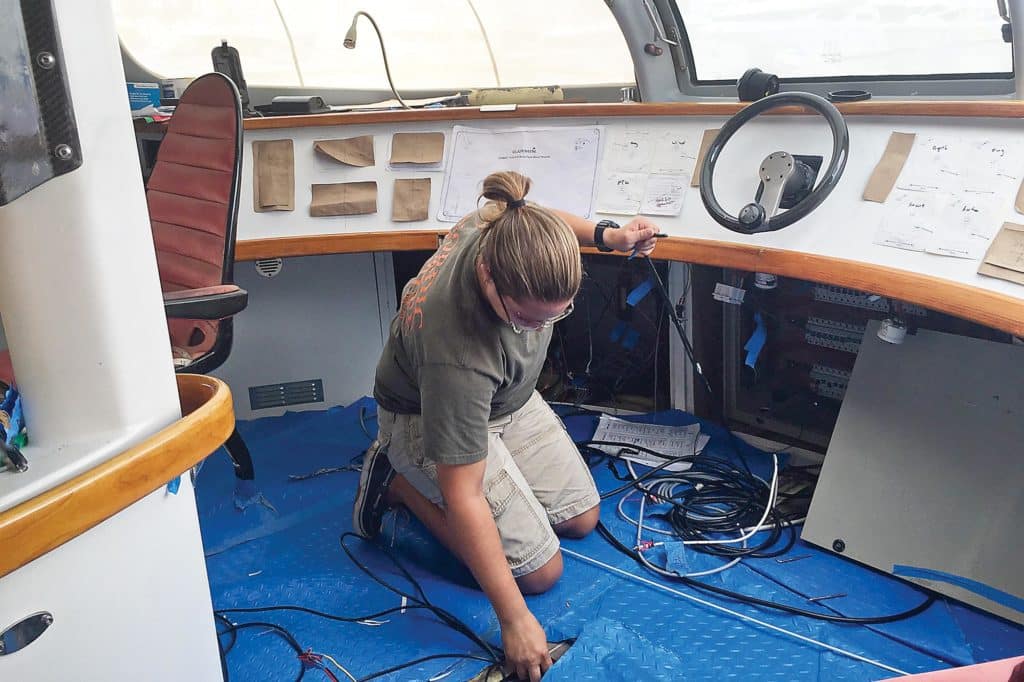
Contemporary electronics can add a lot to a cruising sailboat. For starters, the gains often include easier-to-understand information, and therefore better situational awareness and increased safety. The catch, however, is that new plotters, radars and other instruments can be expensive, both to purchase and have installed. And then there’s the issue of getting new equipment to interface with older-but-still-functional gear. Because of this, plenty of cruisers manage just fine with older electronics that—while dated—still work and help get them from here to there.
But, as with all things marine, even once-high-end equipment eventually reaches its endgame. Trouble is, determining when checkmate is inevitable isn’t always obvious, so I reached out to two experts—Nigel Barron, sales and marketing manager at Seattle’s CSR Marine ( csrmarine.com ), and Rufus Van Gruisen, owner of Cay Electronics in Portsmouth, Rhode Island ( cayelectronics.com )—to learn more about when it’s time to (literally) pull the plug on old kit. In doing so, they also helped shed light on the performance and safety gains that can take the sting out of new-equipment purchases.
“Electronics typically work or don’t,” Van Gruisen says, adding that shy of a catastrophic event such as a lightning strike, obsolescence is the biggest gravedigger for most marine instruments. For example, Van Gruisen points to chart plotters: “New charts often don’t work on older plotters because they take up too much memory. A lot of products become obsolete because they can’t load modern software. A cruiser would need to find old, out-of-date charts to make it work.”
This might suffice in places such as Maine, where the seafloor is generally stable and where up-to-date cartography sometimes relies on old bathymetric surveys, but this certainly doesn’t hold true for places such as Chesapeake Bay or the Bahamas, where seafloors morph with storm events and time.
Another vintage-equipment killer, Van Gruisen says, is that manufacturers eventually stop supporting updates for older electronics. For example, older chart plotters can eventually stop working with current GPS configurations.
Barron agrees that obsolescence can be a problem; seven years, he says, is a reasonable life span for most electronics. He points to issues such as inconsistent data from sensors or transducers, speed information failing to display, or screen pixels going dark as signs that it could be time to upgrade. Plus, he believes, seven years is enough time for the market to offer significantly better products. “A cathode-ray tube television might still work, and an older radar might still work, but there are way-better products available that offer better reliability, lower power consumption and new features.”
Prime examples of this are digital, solid-state Doppler-enabled radars that depict dangerous targets in one color (typically red) on a chart-plotter display, and stationary or benign targets in another color (typically green or blue). This functionality not only makes it easier and more intuitive to read a radar display, but these radars are also designed to overlay this imagery atop cartography on a chart-plotter screen, thus improving the user’s situational awareness.
“In 2010, radar was analog,” Barron says. “In 2021, it’s digital.”
While these technological gains are to be celebrated, especially by cruisers who have plied waters shrouded in Down East pea-soup fog or Pacific Northwest rain, adding a modern Doppler-enabled radar to an older marine-electronics ecosystem isn’t usually a plug-and-play possibility.
“If an owner wants a new peripheral sensor attached to the chart plotter, they might need to replace the plotter,” Van Gruisen says. “It’s sometimes hard to replace one piece of electronics because it might not integrate with other equipment on the boat.”
Because of this, both Barron and Van Gruisen point to a new chart plotter as the place to start for refits both mighty and modest. “If you’re on a budget, you can buy a plotter and add sensors later,” Barron says. “It all starts with the plotter.”
Another common roadblock to easy upgrades involves data networks. While the older NMEA 0183 network protocol allowed discrete instruments to share some data, newer NMEA 2000 (commonly referred to as N2K) data backbones make it easy for owners to add new equipment to their network with considerably less fuss. Moreover, most new equipment is designed and built to work with N2K networks. While manufacturers still commonly support NMEA 0183 by making equipment “backward compatible” or by making an NMEA 0183 version of a new piece of equipment, this could change as N2K becomes increasingly dominant.
The problem, Barron says, is that converting to N2K “isn’t something that’s done in a vacuum. It’s part of a larger installation. There are upfront costs, but it will save you money down the road because it makes it easier to add new equipment.”
Another game-changer that both Barron and Van Gruisen agree on is the advent of the automatic identification system, or AIS. While recreational-level AIS has existed since 2006, recent years have seen a massive embrace of this technology by mariners of all stripes.
“The rate of uptake took us all by surprise,” Van Gruisen says. “AIS is now more useful than radar. It won’t protect you from all targets in pea-soup fog, but it’s easier to read than radar.” This is especially true if AIS targets can be overlaid atop cartography on a chart-plotter screen. (Or better still, overlaid atop radar and cartography.)
“AIS is a fraction of the cost of radar,” Barron says, adding that AIS costs roughly $1,000, while a new radar can fetch $3,000. Moreover, he says, falling prices have also encouraged mariners to embrace newer technologies. “The price difference between an AIS receiver and an AIS transceiver has become so narrow, why not transmit your position?”
While AIS and Doppler-enabled radar are two great examples of modern technologies either usurping older gear (such as analog magnetron radars) or revolutionizing marine safety (in the case of AIS), there are other gains to be had by upgrading, especially as prices on no-longer-bleeding-edge technologies fall. Some examples of this include forward-looking sonar, side-scanning sonar, thermal-imaging cameras, and bigger, easier-to-use screens and user interfaces.
“For Alaska cruising, it’s nice to have something more than a numerical representation of depth,” Barron says, noting that more adventure-minded cruisers are investigating forward-looking sonar. Van Gruisen agrees, adding that some Bahamas-bound clients who want to navigate through skinny waters have been gravitating toward forward-looking and side-scanning sonar.
Other new technologies worth a look include Raymarine’s ClearCruise AR (the “AR” stands for augmented reality), which uses cameras to place AIS-like tags above aids to navigation and other targets on a video feed that’s displayed on the chart plotter. And then there is B&G’s SailSteer, which takes numerical instrument data—apparent wind angles, true wind direction and course over ground—from the boat’s nav system and creates an easy-to-read onscreen graphical representation of the wind, which can make sailing easier and safer.
“I don’t see people coming in saying, ‘I want ClearCruise AR,’” Van Gruisen says. “But when it’s time for an upgrade, that’s the kind of technology they’re looking at.”
Ultimately, Barron says, sailors typically upgrade their electronics for two reasons: “Things break, or they go out on their friend’s boat and realize that it’s time to get out of the Stone Age.”
Should either of these descriptors apply to your sailboat, the good news is that today’s electronics offer far-better user interfaces, situational awareness and safety features than old-school gear. And while there’s no escaping the associated upgrade costs, this investment should deliver a significantly better time on the water.
David Schmidt is CW’s electronics editor.
- More: Electronics , Gear , print 2021 april
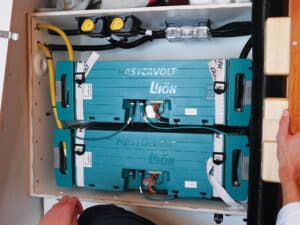
Generators Not Included
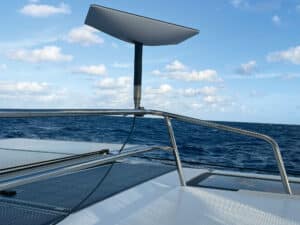
The Days of Dishy McFlatface Have Arrived

C-Map Updates North America Charts

Setting Course for a More Sustainable Future
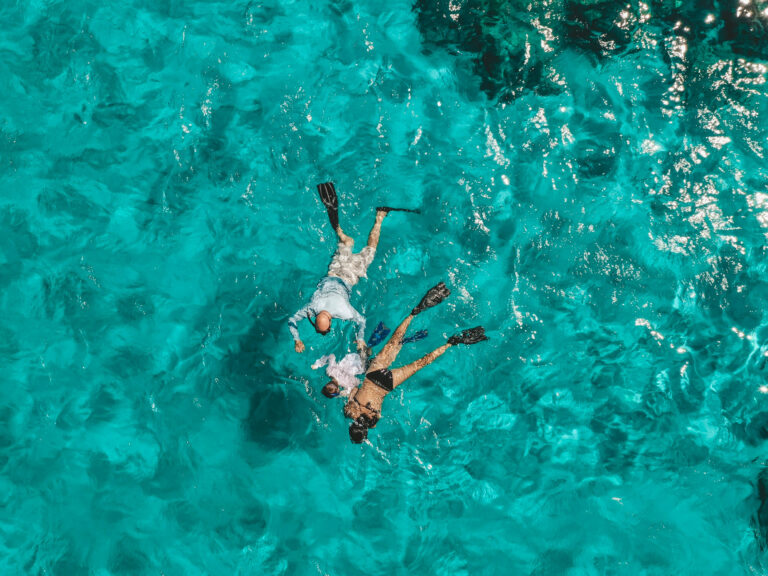
10 Gems of the BVI
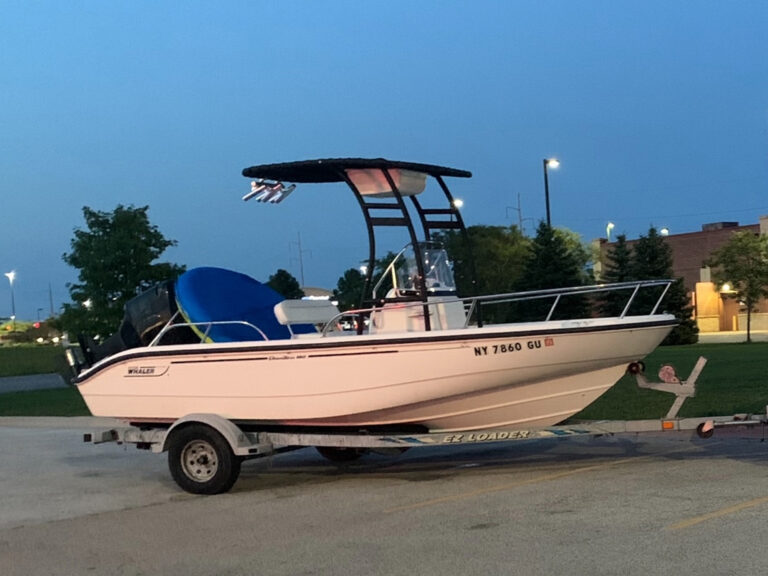
For Sale: A Freshwater Find
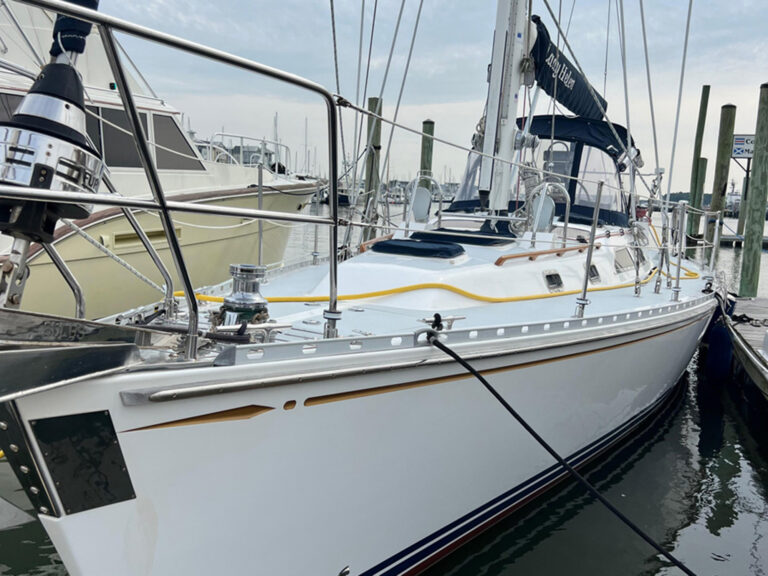
For Sale: 2002 Hylas 46
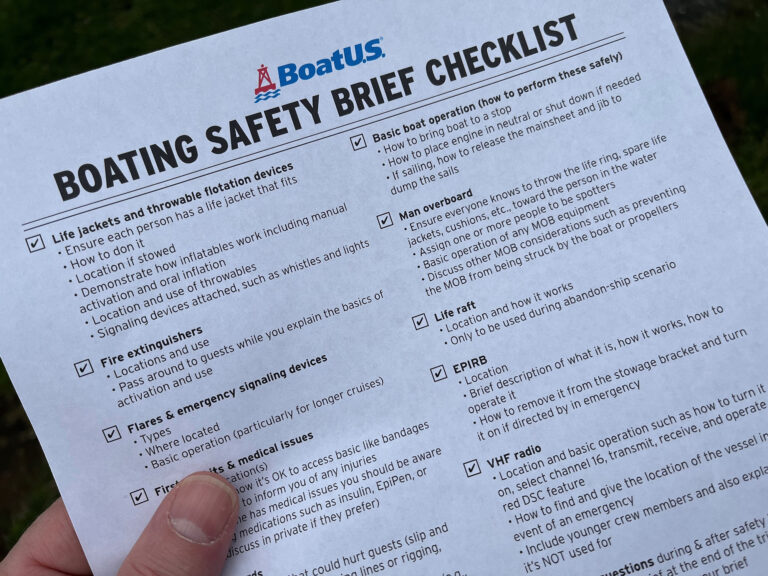
7 Boating Safety Tips for Summer Cruising
- Digital Edition
- Customer Service
- Privacy Policy
- Email Newsletters
- Cruising World
- Sailing World
- Salt Water Sportsman
- Sport Fishing
- Wakeboarding

Best Sailing Racing Electronics

Last Updated by
Daniel Wade
July 5, 2023
Key Takeaways
- Sensors and other fancy LCD screens can help track important data while sailing
- This access to crucial data can help make informed decisions while racing
- The accuracy will be tested but you can be very close to the wind and boat speed
- Various technology can give you the ability to remain safe on the water
- Consider factors like a budget in order to find the best racing electronics for you
Electronics on a sailboat can make life easier and more convenient. But what are the best sailing racing electronics?
The best sailing electronics for racing are the Airmar DST, Dometic Steering Actuator, and the Garmin Quatix Marine Smartwatch. Other electronics racers can utilize while sailing include the Raymarine Axiom, Garmin GPSMAP, and QWORK Battery Monitor.
In my experience, it can be easy to overwhelm yourself with too many electronics. Try to aim for what is best in your situation and how it might apply to your boat while racing.
Table of contents
Top Eight Marine Electronics for Racing or Sailing
There are an enormous amount of electronics that you can equip on your sailboat to help you while racing. Keep in mind that these will not guarantee a victory but it could help you become a better racer if you are able to pinpoint areas that need improvement.
You do not have to invest your time and money into all of these in order to become a better sailor. But the addition of these items can potentially make or break you getting ahead in races with an understanding of the little details that you are likely missing.

The Airmar DST 810 streamlines speed calibration with its integrated attitude sensor and even has the free CAST app that eliminates the need for expensive computer software. Racers can obtain heel-compensated speed at various angles and ranges.
The 5Hz output allows you to make swift decision-making on the water. This sensor is moderately priced at $399 but it can also measure depth and water temperature (to a tenth of a degree). It can also support hull angles up to 22 degrees so that it can fit on many boats with curved hulls.
- Self-calibration for correcting heel
- Supports hull angles up to 22 degrees
- Might be too much information on the app
Dometic Steering Actuator

The Dometic Optimus outboard electric steering actuator provides racers with total power-steering capabilities with an adjustable parameter that can accommodate any traditional outboard motor. The installation is simple with a quick setup of the electronic helm display that takes the need away for oil or purging.
The system can be utilized with joystick controls and even SeaWays (Dometic autopilot). For more than one engine setup you will need an additional actuator. The price for one engine system is about $5,700 so keep in mind your budget.
- Easy installation
- Very reliable and requires little maintenance
- At $5,700 per unit it is quite expensive for many
Garmin Quatix Marine Smartwatch

No sailing race would be complete without the use of a sailing watch. Club racers can use the Garmin Quatix 7 which offers a broad range of activities to be had on the water. It provides excellent navigation acts and is designed to handle conditions while racing or cruising.
It has a tide tracker and other useful information to keep you up to date while racing. It also has a countdown timer for when you do compete in races to help keep track of when to pass the start line. I have used other marine watches in the past but this has been my favorite overall for its design and functionality.
- Countdown timer for races
- A computer on your wrist that is also waterproof
- Too many features for those that want simplicity
Raymarine Axiom

If you do not want a sailing watch for the GPS capabilities then you should check out the Raymarine Axiom 9 . This allows you to see your instrument display with a variety of important information at your fingertips. They feature tons of memory for anything you want to put on it and I love that you do not have to pull cables through pipework to set up.
If you decide to combine this with other sailing instruments provided by Raymarine then you can tap into features such as cameras and autopilot. Those that want to enjoy fishing when they are not racing can also utilize the sonar feature among other instrument displays.
- Great interface for all of your instrument needs compared to the competition
- Can connect to the network of other equipment by the same brand
- Around a $1,000 without the other features
Garmin GPSMAP

If you want a similar experience to Raymarine products you could opt for the Garmin GPSMAP that doubles as a chartplotter and sonar. It can connect to other Garmin related products on your boat which makes sense if you want everything to work together while racing.
It has a clear display and excellent sonar features that allow you to see what is around you underneath. This lets you have some idea of whether or not you can race in shallow waters in new areas. I enjoy not having black boxes and sharper resolution compared to other brands.
- Compatible with other Garmin system offerings
- No black boxes and has clear displays
- Around $2,400 so consider your budget
QWORK Battery Monitor

Depending on what type of boat you have you will likely need to keep an eye on your battery to ensure it is operating like it should be. This is where an excellent battery monitor comes in handy like the one by QWORK . It lets me know if my battery is becoming weak or if I have power being zapped from something left running.
It features an easy to read LCD display that gives you all the information you need to check the battery life on your boat. It can also store the last voltage reading after the system shuts off so you know that the battery is charging effectively or if you need to take action.
- Affordable and easy installation
- Gives accurate battery reading
- Some users found it difficult to understand
Raymarine Speed Instrument

In races for sailing you need to know how fast you are going but you may not want to spend a ton of money on instrument displays that have an abundance of information. Instead you could opt for something like a knot meter.
Raymarine offers a great speed instrument to racing sailors on a budget. This gives you the opportunity to see the average speeds of your boat without breaking the bank and with an easy setup. I love this because you get valuable speed information for a great price.
- Best for tracking speed while on a budget
- IPX6 waterproof rating and three year warranty
- Other devices might have this information so check your instruments
Ritchie Navigator Inclinometer

For sailors that want to sail on a budget and still receive important data you could opt for an inclinometer by Ritchie Navigator. At round $30 you can simply attach this to your boat and see how your boat responds in real time.
This will allow you to see the heel of the boat and give you the option to make adjustments as you go to stay in a straight line. I like it since it helps give me an idea for staying in line on a course for windier days. This is a handy device to optimize your performances during sailing.
- $30 for a great addition to the boat
- Gives accurate heel readings and is easy to see
- Other devices could have this information so check your instruments
Why Do You Need Electronics for Sailing and Racing?
There are many marine electronics for sailors that can help aid you in becoming better at sailing. There is not a perfect tool out there to help you win races or make you better than anyone else.
However you should opt for racing electronics to help you out in a variety of situations. Without the use of these would make situations interesting out at sea or potentially a dangerous occurrence.
Call for Help
In addition to a marine radio that you should already have you might want to equip your boat with another form of communication. Most technology is equipped with WiFi or the capability to be connected to data so that you can receive messages or call out for help.
Other crucial safety measures include AIS that can help track your boat. If you happen to lose your signal then your last known position can be tracked.
Latest Navigation
If you are using old maps to navigate then you might be fine in a lot of areas. But what about sailing in a popular area that has been built or modified due to disasters or other events?
Having a great navigational tool to help guide you through an area is best for locations you are unfamiliar with. This allows you the opportunity to navigate safely without potentially damaging your boat or getting lost and can help you stay on the race course if you have set an outline.
Weather Updates
Most sailors check the weather the day they are going out at sea or joining a race. But the weather can be unpredictable in many locations across the world.
It is ideal to have something that allows you to track weather updates as you are sailing. This could be updates for dense fog or a strong thunderstorm forming off of the coast with damaging winds.
Instruments with Crucial Data
Instruments provide important data for sailors that need to make adjustments on the fly while racing. This data could be something as simple as wind speed and the boat’s current direction.
Without the use of these instruments you are unlikely to know when to make tactical decisions during a race. These are the little things that add up to a potential victory and everyone is likely using something to gain a slight edge.
Boat Performance
If you are preparing for a race it is ideal to have the most information available to make the best decisions. Understanding how the boat is responding to waves and the wind is one aspect but other key data points can help you make informed decisions on how to navigate your boat better. This will allow you to test out new techniques and see what works best at obtaining top speeds on your boat.
How to Find the Best Sailing Electronics
What is considered the best racing technology to you might differ to someone else. There are a variety of different uses that can make a difference on your boat versus another.
Determine Your Desired Use
Your sailing goals are likely going to be different than someone else’s. It is important to understand what you are planning to do on your boat before trying to add a lot of technology on it. If you like fishing and racing then you might want something that can help out for both sonar and GPS capabilities.
Research Various Brands
Brands are likely the first thing you see for a particular product. Some will vary in price and quality. It is crucial that you research at least three different options for whatever product you want so that you have various prices and quality to see.
Make Sure it is Compatible
Not every electronic device for a boat will be able to join your adventure. This includes the existing wiring or other sensors that could affect how it is used. This might need an expert to install if you plan on updating older technology on your boat.
Consult a Professional
You might want to ask a dealer that specializes in boat technology. They will likely be yout best bet to advise you in various additions to your boat or how to install them. If you choose them you might also get a craftsmanship warranty but always check beforehand.
Check Out Boat Shows
Boat shows are a great place for brands to try out new and improved technology. This allows you to see first hand what the electronics are intended to be used for and how it could apply to you. This also gives you the luxury of asking important questions and troubleshooting tips that you may encounter.
Consider the Warranty
There are many brands that offer a warranty on their products. This is important to keep track of in the event that the technology decides to stop working or has issues updating. Strong customer support is crucial for a long term customer.
Ease of Installation
Once you have conducted your research you will likely have a good idea on what is easy to install and what is not. Be mindful of what type of devices you need to have installed by a professional since that will add in the costs on top of the device itself. If you want to do it all yourself then you should consider ones that are the easiest to set up.
What Other Customers Have to Say
It is no fun reading bad reviews or mixed ones that do not offer a lot of information. But you can likely see where people are coming from on a bad review at least.
Consumer reviews will give you the cherry on top of your research in order to find the best product no matter what. If someone else reports the type of boat and activity on the water they used the technology for then you will likely have a good opinion of the brand.
Have a Budget
Budget is one of the most important aspects in determining what you can afford and what you can add to your boat. Even though you might like a certain brand you might not be able to integrate their features if they are at a higher price point.
This also goes hand in hand with your intended use and what you plan on using the most on your boat. Narrowing down this will greatly help your budget.
Related Articles
I've personally had thousands of questions about sailing and sailboats over the years. As I learn and experience sailing, and the community, I share the answers that work and make sense to me, here on Life of Sailing.
by this author
Personal Health and Gear
Most Recent

Best Sailing Duffle Bags: Top Picks For Boat Travel
September 27, 2023

Best Sailing Racing Compasses
June 7, 2023
Important Legal Info
Lifeofsailing.com is a participant in the Amazon Services LLC Associates Program, an affiliate advertising program designed to provide a means for sites to earn advertising fees by advertising and linking to Amazon. This site also participates in other affiliate programs and is compensated for referring traffic and business to these companies.
Similar Posts

Best Boating Watches For The Avid Sailor
May 1, 2023

Best First Aid Kits For Boat Safety
April 18, 2023

Who Has To Wear A Life Jacket On A Boat?
April 10, 2023
Popular Posts

Best Liveaboard Catamaran Sailboats
December 28, 2023

Can a Novice Sail Around the World?
Elizabeth O'Malley
June 15, 2022

4 Best Electric Outboard Motors

How Long Did It Take The Vikings To Sail To England?

10 Best Sailboat Brands (And Why)
December 20, 2023

7 Best Places To Liveaboard A Sailboat
Get the best sailing content.
Top Rated Posts
Lifeofsailing.com is a participant in the Amazon Services LLC Associates Program, an affiliate advertising program designed to provide a means for sites to earn advertising fees by advertising and linking to Amazon. This site also participates in other affiliate programs and is compensated for referring traffic and business to these companies. (866) 342-SAIL
© 2024 Life of Sailing Email: [email protected] Address: 11816 Inwood Rd #3024 Dallas, TX 75244 Disclaimer Privacy Policy

+44 (0)1590 718182

Essential Sailing Instruments – Let’s Cover the Basics
Sailing instruments are hard to get right. They’ve got to be accurate, durable and easy to read in all kinds of conditions; from blazing sun to seething tempest. Even on a good day, nothing about measuring a heaving mass of water and gusting wind is straightforward.
All of the components used in a sailing instrument installation need to be compatible with each other, too – so it’s a good thing that all parts from A+T Instruments are compatible with B&G products, and can directly replace them in a refit.
Anyway – while there’s no substitute for good sailing experience and knowledge of the sea, electronic instruments are essential in larger vessels. You might be able to sail a small boat or dinghy with just your senses to guide you, but on a larger craft, sailing instruments extend your senses and intuition, allowing you to “feel” the environment beyond your reach. This
allows sailors to make better decisions at sea and react faster.
In this article, we’ll cover the fundamentals of sailing electronics – like using a sailboat wind sensor and depth sensor – for a barebones, from-scratch sailing instrument installation. We’ll give you the basics of what’s needed and why, going deeper (no pun intended) into some of the more important sensors for sailing.
1. Depth sensor
Above all other sensors, depth is the most important. Running aground is a dangerous mistake, even if it’s just a keel strike, so knowing the depth is vital.
A depth sensor works by emitting pulses of ultrasonic sound, in a range about 10 times higher than the highest-pitched sound humans can detect.
The sound travels through water, and then bounces off the seafloor as an “echo”. The echo is then collected by the depth sensor, which times the difference between the pulse going out and the echo being received. Then, by calculating the speed of sound in seawater (around 1,500 metres per second) against the time it took to hear the echo, the depth sensor provides a depth reading.
They’re very accurate, and give a depth reading up to around 100m or so – more than enough to prevent running aground.
2. Heading sensors: compass and GPS
GPS is standard equipment on even the smallest of seafaring vessels – along with compasses. And the humble compass is a mainstay of maritime instruments for good reason. It’s a good idea to have analogue and digital compasses installed on a sailboat, and to be able to read both.
A digital compass can be fed into a main display for getting quick overviews at a glance, and can provide greater accuracy. But in the event of a power failure and poor visibility, an analogue compass might be the only reference point you have to guide you home.
3. Speed sensor
The speed of a craft on water is deceptive, thanks to fluid dynamics. Even an accurate measure of speed can still be misleading, depending on where you measure from – it’s all relative. But it’s important to get right, because it’s one of the main ingredients to calculate position by dead reckoning (plotting an object based on heading, speed and time).
Speed through water (STW) and speed over ground (SOG) are the methods by which boat speed can be measured. SOG is relatively easy to get with GPS – but STW is variable. For one, currents can be moving with or against the vessel, affecting the measured speed through water. On top of that, the vessel itself creates a flow field as it moves, which can
affect the speed of the water around it.
The effect of the flow field can be mitigated by positioning the sailing speed sensor as close to the centre of the hull as possible, while being as far from any turbulence-inducing surfaces as possible.
There’s a lot to consider. So, why not just use SOG? Well, SOG is helpful for navigation between fixed points – but currents will affect the STW. This will profoundly affect your navigation and the proper calculation of wind if it’s not accurate.
4. Wind sensors
Okay – finally, we get to wind. Every sailor can use their senses to tell where the wind is blowing from, and use it to move, navigate, and calculate routes. But, like anything in fluid dynamics, the wind is a trickster, and to measure it properly takes some cunning…
The true wind is what a stationary object on the water experiences. The direction and speed are the same for any stationary object in that vicinity – hence the term true wind.
Apparent wind
The apparent wind is harder to describe, but we’ll give it a go. Imagine it’s a windless, summer’s day and you decide to go for a bike ride. On the way, you zip down a big hill – and even though it’s a windless day, you experience the sensation of wind blowing on your face and arms. That’s because your body cutting through the air has created a sensation of wind
rushing past you. The same thing happens when you’re sailing. The true wind and the apparent wind are different, because of the motion and heading of the vessel.
So, in order to get an accurate reading, true wind direction must be calculated from multiple sensor inputs – but factors such as leeway (sideways “slipping” on the water) and heading all impact the course of the boat.
Wind sensors and wind calculations are a world unto themselves, so we’ll be sure to cover
them in more detail soon.
And that about covers it – these are the four main categories of sensors and instruments that will form the backbone of any sailing instrument installation. Of course, now you’ve got all this data, you need somewhere to process it all and display it.
Processors and instrument displays
Sailing instrument processors are highly specialised, super-rugged computers, made to calculate and crunch all the data as quickly and accurately as possible. They’re like the “brain” of the boat, gathering all the information from the sensors, and making sense of it.
The processed info is then sent to a display, for the sailor to read. Now, sailing electronic displays are a wholly different kettle of fish to your garden variety iPad or mobile phone screen; they have to work reliably more than they have to look pretty. We’ll cover sailing instrument displays in detail soon, in another article – but it’s not uncommon to find seemingly basic monochrome LCD displays or analogue dials on even the most advanced ships and superyachts for this reason.
Shop by category
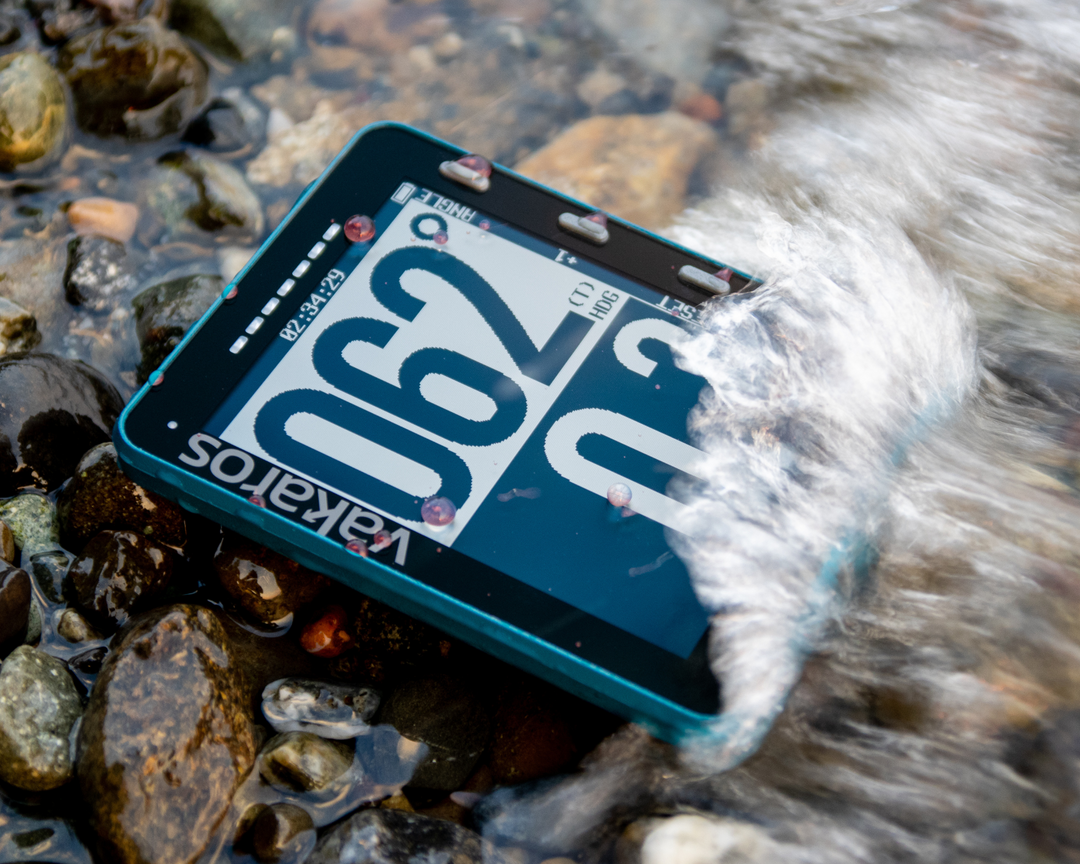
"The Atlas is a huge part of my training: we use data and video to get better and push to the Games"
This section doesn’t currently include any content. Add content to this section using the sidebar.
From the journal


What Instruments Do You Need On A Sailboat? 10 Items!

Sailing on a sailboat needs various instruments to reach the destination and handle certain issues on the way. Seamanship is also about extensive preparation in terms of infrastructure and concrete knowledge about the boat. If you are setting up your sailboat with the necessary equipment, you need to know the primary set of instruments.
The essential list of instruments you need on a sailboat includes a depth gauge, speed log, wind instrument, VHF radio, multifunction displays, chart plotter, GPS, AIS, and radar. You can also add display and musical instruments for clarity and entertainment, respectively.
In this article, let’s look at the significance of instruments on a sailboat and the possible types of instruments you can use on a sailboat.
Why Use Instruments For Sailing
Imagine sailing across water currents without instruments and halting suddenly because you either feel lost or experience environmental troubles. Isn’t your sailing experience getting complicated?
Well, this is the exact reason to use instruments; to simplify and enhance the sailing experience.
Aren’t convinced yet? Here are some more reasons for highlighting the importance of instruments for sailing:
- Sailing instruments give a detailed picture of the environmental condition while traveling to your destination.
- Sailing instruments alert you during an emergency situation, such as weather or other boats in the area.
- Sailing instruments allow you to know your sailing pattern better. Further, it’s possible to note the vessel’s position as you continue sailing. (Waypoints)
- Most importantly, sailing instruments offer better decision-making opportunities to sailors whenever a crisis situation is anticipated.
- Aligning and managing your vessel based on weather conditions is feasible only with sailing instruments in place.
Sailing instruments act as helping hands to sailors and their crew in navigating and adding ease to the sailing experience.
Instruments To Have On A Sailboat
Some of the basic instruments that every sailboat should contain include a depth gauge, speed log, radar, anemometer, wind instruments, engine monitors, multifunction displays, GPS, and chart plotter.
Irrelevant to what your budget is, it’s vital to equip your sailboat with these instruments. Otherwise, your experience may become more difficult.
Let’s look at the purpose of each instrument.
1. Depth gauge
The purpose of a depth gauge is to inform the depth of water beneath the keel. It allows you to navigate better and also align anchor with relevant scope. Additionally, you can link this device to other display instruments.
2. Speed log
Are you sailing at the right speed? Sometimes, we enjoy sailing to the extent that we navigate and sail too fast or too slow. To avoid possible issues that can arise due to speed, you need a speed log.
The log informs the presence of current and estimated arrival time. Some global positioning systems (GPS) include speed logs. Invest in the right instrument, and you won’t regret it!
Do you sail across multiple water currents? GPS is undeniably the first instrument to purchase for your sailboat. The purpose of a GPS is to know your present position on the water and then make a decision about the direction you want to go.
Thanks to technological advancements, there are integrated GPS instruments that are cross-compatible and also include other functionalities needed for a sailboat.
Radar is widely assumed as an expensive instrument for a sailboat, but it’s quintessential if you handle night sails or long routes. Radar gives a clear picture of boats and other elements on your route to the destination.
If you skip this instrument, you may be vulnerable to sea traffic or get lost during night sails. Imagine this instrument as a safety guide for your boat.
You may need an AIS or automatic information system , it’s affordable and includes a transceiver and a receiver. It works similarly to radar in identifying vessels around the location. However, most AIS instruments are easy to connect to your existing display unit. To find out more about AIS and radios, check out my other article below:

6. Chartplotter
Do you have a sailboat? Then you SHOULD have a chart plotter. We can’t stress the valuable nature of this instrument enough.
Most basic sailboat instrument packages come with a chart plotter in them. Some chart plotters also include other functionalities like a depth gauge, AIS, GPS, and speed log.
If you have a mobile phone or a tablet installed on your sailboat, you can download the corresponding app and start using the instrument.
Note: Ensure that the device is waterproof and has at least 4GB RAM to gather consistent information on navigation.
7. Multifunctional displays (MFDs)
The central instrument of your boat is a multifunctional display. Although you have several instruments loaded on your sailboat, you can integrate them into this one display instrument and then access the data. Above all, this display instrument has a touchscreen making the process more interactive.
Irrespective of the size of your boat, it takes only a few minutes to understand the interface of MFDs.
Can you believe that you can also control all switches, doors, and windows through this MFD?
Tip: Choose a fully networked instrument that is multipurpose and displays bright numbers, so you get a clear guide.
You can also choose an MFD based on the size of the boat. If you’re running short on budget, you can begin with a monochrome display but be informed that it isn’t multipurpose and has limited functionalities.
8. Wind instrument
Wind instrument tops the list of vital instruments. Perhaps, you have an instrument to track the boats around you and keep you updated on weather conditions. In reality, the weather is unpredictable, and you can’t rely on old news.
The advantage of a wind instrument is the opportunity to determine wind angle in the cockpit. Based on the angle, you can regulate the sailing speed. This is a game changer if you’re sailing on a gusty water current.
Tip: Choose a wind instrument that also includes a digital compass, and you’ll thank us later.
Pair it up with a repeater, so it mimics information regularly and also offers detailed insights on weather status, wind speed, appropriate wind angle, and the recommended boat speed.
9. Engine monitors
Engine monitors are generally integrated into MFDs to obtain a complete understanding of the engine’s condition. Similar to cars and other vehicles where you have engine monitors, a sailboat also needs one, and this includes information about fuel, speed, and engine temperature.
Whenever your sailboat is stuck for some reason, you can always look into the engine’s health before developing a plan of action.
10. VHF radio
VHF radio lays the foundation of instruments appropriate for a sailboat. The advantage of VHF radios, lies in their connectivity, even in inaccessible locations. As you steer a sailboat, it’s essential to ensure consistent communication with respective authorities. This allows you to interact with them whenever you’re lost or in an emergency.
Although you all have cell phones to communicate with others, these don’t work when network signals are lost. As a result, a VHF radio is critical in terms of safety for everyone onboard.
Now that we’ve looked at the basic sailboat package, you should look into your budget to purchase other secondary instruments if you’re left with some money. These instruments can save you time and effort. These include autopilot systems and advanced marine radar systems.
In most cases, sailboats already arrive with these basic instruments to ease your sailing experience. You can also purchase them as packages from reliable vendors and maybe strike a good deal.
If you are looking for a radio for your boat check out the article below for some great recommendations!
Which Marine VHF Radio Is Best – Top 8 of 2023
Do You Need Musical Instruments On A Sailboat
Sailing is a positive and interesting experience that can be made even more exciting with the addition of musical instruments on a sailboat. However, guitars and ukuleles are common musical instruments carried by passengers on the boat.
If you’re on vacation, you may carry a barbecue set, lights, and instruments. However, a rule of thumb is to ensure that the electrical system on the sailboat is good enough to let you play the electrical instruments better.
While there’s no limit to the number of musical instruments that you can use on a sailboat, adhere to the following precautions:
- If you’re a sailor, remember to carry a pair of headphones to divert your concentration toward the instruction from MFDs.
- Keep a protocol handy to protect your instruments from extreme temperatures.
- Check the power system associated with the boat before you carry various musical instruments.
- Always take consent from the crew before permitting the use of electronic instruments. Sometimes, crew members can find these instruments annoying when played during the journey.
- Keep an eye on the number of instruments permitted. Otherwise, electrical outlets can be over-occupied, affecting your sailing experience.
As you adhere to these precautions, you can balance between entertainment and professional sailing. It also safeguards passengers on the sailboat.

Final Thoughts
Choosing an instrument for your sailboat is entirely based on the purpose, budget, and usability. If you’re a beginner, you may have a limited budget, and it’s relevant to go with a basic list of instruments. Alternatively, if you’re a professional sailor, it’s important to think of the purchase of these instruments as a one-time investment.
Go for advanced systems that are multipurpose, integrated, and cross-compatible. Such systems may need you to undergo proper training to understand usability and troubleshooting issues. So, check your sailboat today and head on over to a boat instrument portal to make your purchase!
Boatlifehq owner and author/editor of this article.
Recent Posts
Sailboat Racing - Rules & Regulations Explained
Sailboat racing, a blend of skill, strategy, and adherence to intricate rules and regulations, offers a thrilling and intellectually stimulating experience on the water. Navigating through the...
What is the best sailboat to live on? Complete Guide
Embarking on the journey of living aboard a sailboat requires careful consideration of your budget, desired amenities, and storage options. This guide offers a concise, step-by-step approach to...
- New Sailboats
- Sailboats 21-30ft
- Sailboats 31-35ft
- Sailboats 36-40ft
- Sailboats Over 40ft
- Sailboats Under 21feet
- used_sailboats
- Apps and Computer Programs
- Communications
- Fishfinders
- Handheld Electronics
- Plotters MFDS Rradar
Wind, Speed & Depth Instruments
- Anchoring Mooring
- Running Rigging
- Sails Canvas
- Standing Rigging
- Diesel Engines
- Off Grid Energy
- Cleaning Waxing
- DIY Projects
- Repair, Tools & Materials
- Spare Parts
- Tools & Gadgets
- Cabin Comfort
- Ventilation
- Footwear Apparel
- Foul Weather Gear
- Mailport & PS Advisor
- Inside Practical Sailor Blog
- Activate My Web Access
- Reset Password
- Customer Service

- Free Newsletter

Pearson Rhodes 41/Rhodes Bounty II Used Sailboat Review

Hallberg Rassy 42 Used Sailboat Review

How to Perform Your Own Pre-Buy Inspection

Beneteau 323 Used Boat Review

How Does the Gulf Stream Influence our Weather?

Can You Run a Marine Air-Conditioner on Battery Power?

Preparing Yourself for Solo Sailing

Your New Feature-Packed VHF Radio

Practical Sailor Classic: The Load on Your Rode

Anchor Rodes for Smaller Sailboats

Ground Tackle Inspection Tips

Shoe Goo II Excels for Quick Sail Repairs

What Oil Analysis Reveals About Your Engine

An Unusual Sailboat Shines a Light On A Sustainable Future

Is It Time to Get an Electric Dinghy Motor?

Bottom Paint 30-Month Update

Battle of the Teak Cleaners — Snappy Teak-Nu vs. Star Brite

New Seacocks for the Offshore Sailor

Bottom Paint Care

Are E-bikes Worth the Extra Weight and Cost?

How to Handle the Head

How to Select Crew for a Passage or Delivery

Preparing A Boat to Sail Solo

Re-sealing the Seams on Waterproof Fabrics

Waxing and Polishing Your Boat

Reducing Engine Room Noise

Tricks and Tips to Forming Do-it-yourself Rigging Terminals

Marine Toilet Maintenance Tips

Learning to Live with Plastic Boat Bits

A New Era in Weather Forecasts
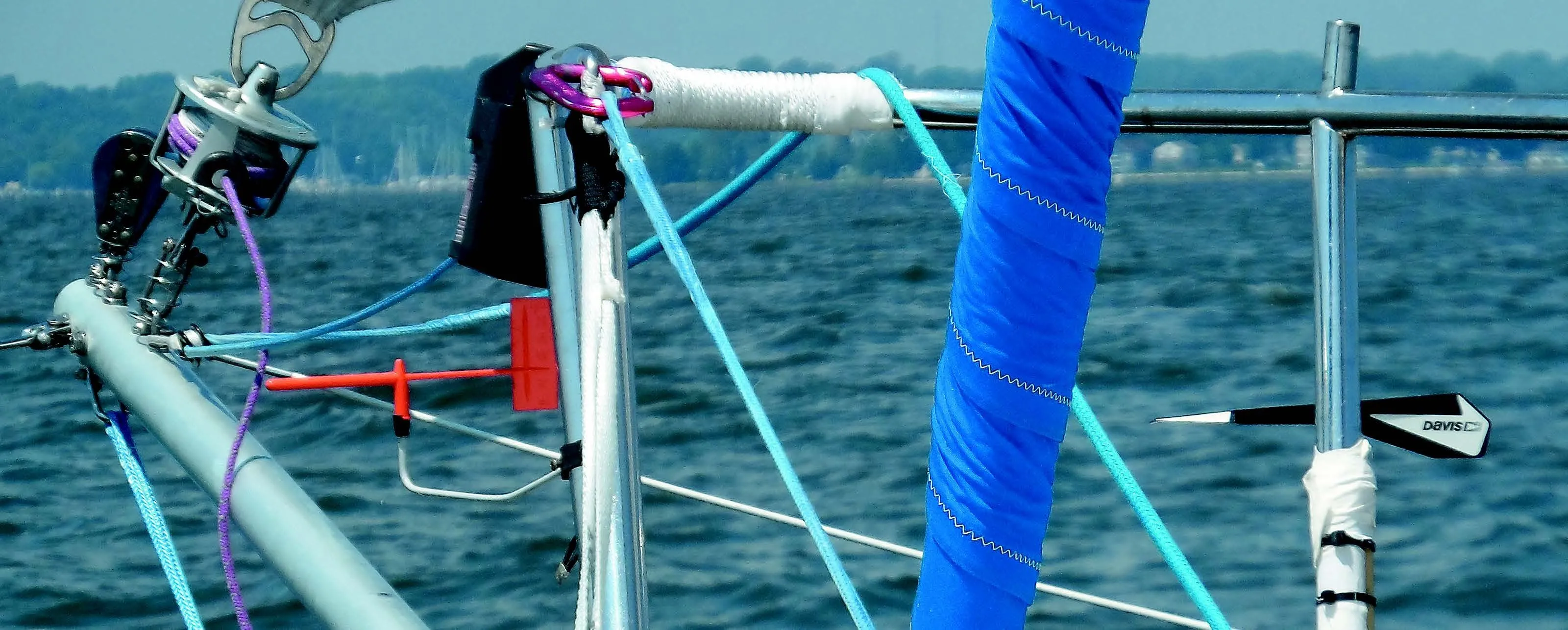
Deck-level Wind Vanes
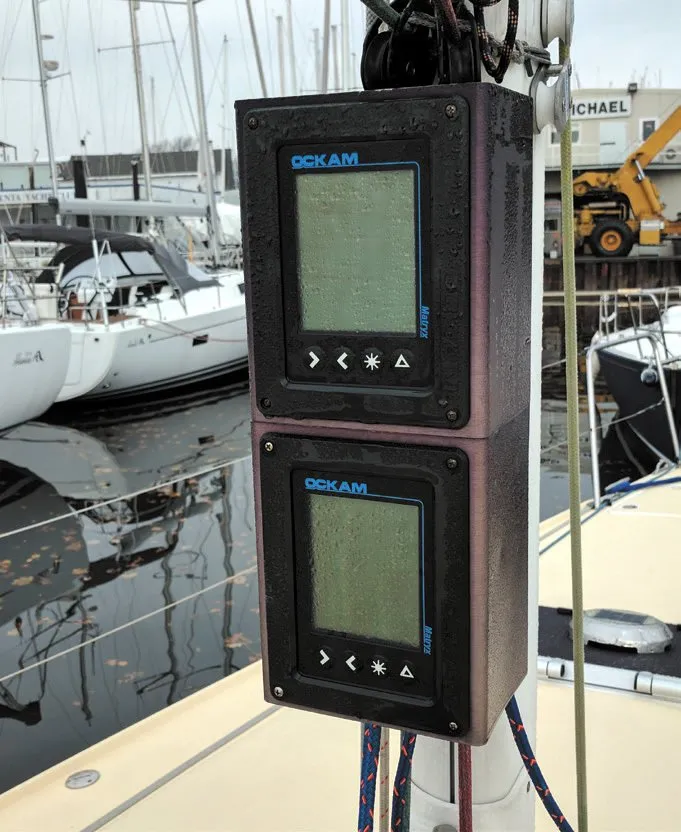
Testing the B&G Zeus3 Nav System
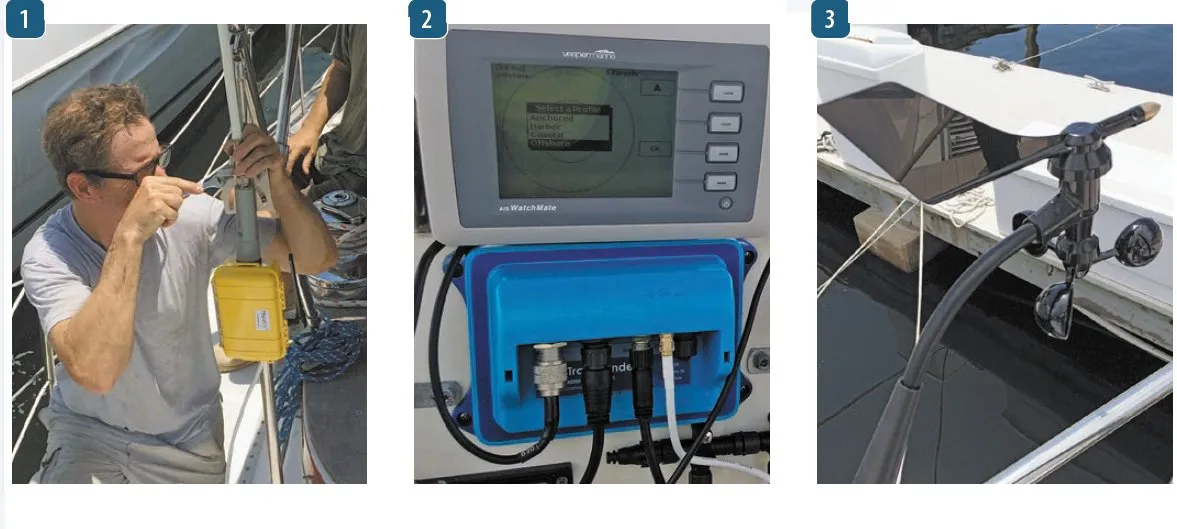
Riding the Wireless Technology Wave

Marine Weather Forecasting
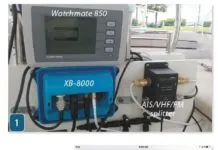
Vesper Class B AIS Sea Trial
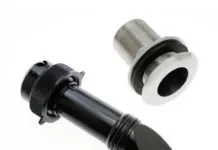
Sonar that Sees Whats Ahead
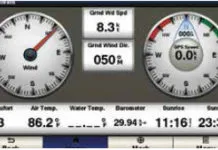
Ultrasonic Wind Sensor Test
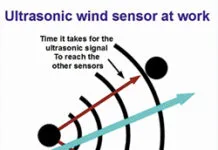
How Do Ultrasonic Wind Sensors Work?
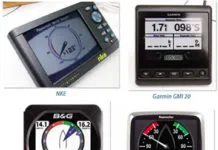
Reading the Wind Series, Part 3
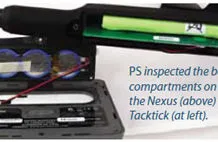
Wired vs Wireless
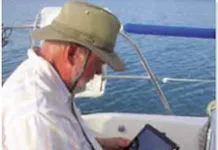
Wireless Multiplexers
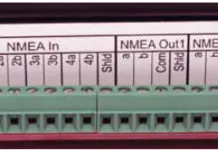
A NMEA 2000-and Beyond-Survival Guide
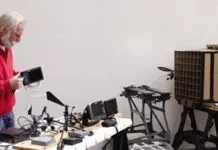
Wind Systems Part 2: Data Display and User Interface
Latest videos.
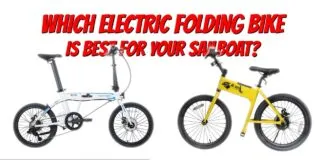
What Is The Best Folding Bike For Your Sailboat?

The No Expense Spared Antigua 60 Cruising Sailboat Soolaimon

How To Buy Sails – With Joe Cooper

Bavaria C42: What You Should Know | Boat Tour
- Privacy Policy
- Do Not Sell My Personal Information
- Online Account Activation
- Privacy Manager
× You are using an outdated browser. Please upgrade your browser to improve your experience.
We Ship Worldwide! | FREE SHIPPING! for US Continental orders over $99. Click for details.

Shopping Cart
Your cart is currently empty..
FREE SHIPPING! for US Continental orders over $99 click for details

Vakaros Atlas 2
B&G Triton² Digital Display
Calypso Wind Meter - Portable Solar (25 m/s)
Sailing Instruments

Be it for safety, navigation or competition, all sailors need information about their boat's performance and its environment. Marine electronics manufacturers, which have increased the accuracy, quantity and accessibility of data from electronic sailing instruments. Here some of them.
B&G's Sailing & Wind Instruments are famous around the world for their durability, accuracy and clarity. Whether you're cruising or racing, the instruments can display speed, depth and wind data among other features you will want to see on our award-winning sailing instrument displays.
For 25 years NKE has been developing innovative instrument systems decided to navigation and performance. Whatever your program, should it be racing or cruising, solo or crewed, NKE instruments are designed to answer all your needs at every level.
Velocitek builds high-performance sailing instruments. Their devices are designed to give you the critical tactical information you need, when you need it.
MAURIPRO Sailing, your direct access to Sailing Instruments and all your other sailing and boating needs.
Copyright © 2024 MAURIPRO Sailing LLC.
Yachting World
- Digital Edition

Best sailing watches: 16 options for racing and cruising
- October 17, 2023
Fox Morgan, Phil Sampson and Roger Hughes test and review 16 of the best sailing watches available with functions for racing and cruising sailors

The best sailing watches can offer a multitude of functions, from MOB alerts to tidal calculations and large faced race count down timers. And yet still there’s utter simplicity of a waterproof self winding timepiece.
Just as tablets and even smartphones have revolutionised how sailors use multifunction displays and instruments, so the latest smart watch technology has now firmly filtered into sailing. While we’re now familiar with using our watches to give us directions, make calls and send messages, and act as a repeater screen on our wrists ashore, so the latest sailing watches also make navigation, data and comms technology wearable afloat.
You’ll see that Garmin have several entries in our best sailing watches guide and if you’re specifically after a Garmin, we have rounded up the best of those in this guide to the best Garmin watch for yachting sailing and more .
However, the cleverest watch is not always the best watch for sailing. For racing an extremely simple and speedy to operate model may suit better. Price is not always an indicator of functionality either; even some of the least expensive sailing watches, like the Casio we showcase below, can be packed with features.
At the other end of the scale, luxury horology brands – including Rolex, Panerai, and Omega among others – have long been closely associated with sailing, seeing it as the perfect sport to demonstrate their style, waterproof and ruggedised qualities, and accuracy.
In making our selection of the best sailing watches, we’ve chosen those with features specifically suitable for wearing aboard. That doesn’t mean, however, that they float, so be sure to do the clasp up securely and be wary of pulling off jacket sleeves in a hurry and losing your prized timepiece overboard!
Editor’s top choices at a glance
Best sailing smart watch – Garmin Quatix 7 Best premium sailing watch – Garmin MARQ Captain Best value sailing watch – Casio Lithium Quartz Best racing sailing watch – Ronstan Clear Start Race Timer
Best sailing watch for multifunction use
Garmin quatix 7.
Best sailing smart watch
Specifications: Apple or android smart phone compatible, Sizes: 47mm / 51mm, Weight 70g, Battery life: up to 16 days with screen on by demand, GPS tracking, waterproof to 10 ATM
Reasons to Buy: Large easy to read face | incredible versatility for an array of lifestyle activity | healthy wellbeing and boat interactivity | customisable to suit individual needs Reasons to Avoid: Battery life not as good as the Quatix 6 if screen is always visible | bright facia can be distracting | touchscreen is pointless without the additional kit it interfaces with
Garmin’s latest sailing smartwatch includes improvements to strengthen integration with onboard electronics.
It’s a touchscreen model that can, for instance, be used to control MFD displays or Fusion audio systems, as well as Garmin autopilots.
You can also pay for things with contactless payments, but you’ll need to use an intermediary app, such as Curve if you are in the UK as British banks haven’t signed up for that function directly yet.
So let’s address the major change for the Quatix 7 over the Quatix 6, and that’s the display. Plenty of folks complained about the darkness or difficulty seeing the Quatix 6 screen, so they’ve addressed that with a much brighter lit up style of screen. It is very bright even when turned to its dimmest setting. To save the battery from being drained unnecessarily at night, there’s a night time version of the watch screen where you can view it as a digital numeric mono display, on demand, otherwise the screen is completely blank. This brighter clearer display does come at a compromise of battery life or screen saver settings.
The extra screen size in the same outer bezel size though is really very nice. Maps and other tracking options can be easily seen.
High end Sapphire models add a new ultra-clear AMOLED touchscreen.
The watch can output directly to Strava and myfitnesspal along with other apps according to your preference. We like this watch very much indeed and it is currently the best smart sailing watch for all round functionality. Pricey though, but worth it.

Garmin MARQ Captain
Best premium sailing watch
Specifications: Type: Smart | Size: 46mm
Reasons to buy: Weather and tidal data | MOB and GPS functions | Stream boat data to your wrist Reasons to avoid: Full extent of capabilities is governed by the onboard technology it’s connected to | Premium price
Tested by: MBY Editor, Hugo Andreae
Our top priced pick comes from wearable tech-specialists, Garmin. The MARQ Captain sailing watch comes packed with marine-relevant features.
Functions include weather and tidal data for your home port, a regatta timer to pinpoint starting times, a ‘tack assist’ function to determine whether you’re on lift or a header, a man overboard button and GPS.
The full extent of its capabilities is governed by the onboard technology to which it is connected, but possibilities include streaming boat data direct to your wrist wherever you are on the boat and controlling products from the Garmin-owned Fusion range of audio systems.

Garmin Instinct 2S Solar
Specifications: Type: Smart | Size: 40mm / 45mm / 50mm, weight 53g(2oz)
Reasons to buy: GPS positioning on charts | barometric pressure and compass | Smartphone connectivity | An incredible amount of styles and colours | A single charge lasts 14 days Reasons to avoid: Premium price without a premium design
Tested by: Tech Editor, Fox Morgan
The Instinct 2, launched in February 2022 is Garmin’s all-round watch, which they call their outdoors watch. Features that are particularly relevant to sailors include GPS positioning on charts; barometric pressure and a compass.
It has smartphone connectivity, receives emails and texts, and can control music via a phone. This watch also has an inbuilt thermometer and heart rate monitor.
The Garmin Instinct is available in no fewer than 20 different styles and colours. It’s actual diameter is 47mm (1 13/16” in) but the viewable face is 32mm (1 1/4”). The Instinct is 16mm (5/8” in) thick and weighs 53g (2 oz).
For racing sailors, it also has multiple start sequence options. We have an indepth review from long term testing of this watch coming soon.
The Garmin Instinct watch is a good alternative for anyone seeking a more moderately priced alternative to the Quatix 6.

Garmin Quatix 6 Multisport Marine Smartwatch
Specifications: Apple or android smart phone compatible, Sizes: 47mm / 51mm, weight 82g, Battery life: up to 16 days with screen always visible, GPS tracking, waterproof to 10 ATM
Reasons to buy: Suits a multitude of water activity | Highly customisable | An incredible amount of data available on your wrist | A single charge lasts 14 days Reasons to avoid: High level of functionality is not for the technologically phobic
This watch I tested comprehensively for several weeks/months – it is a very smart design, with functions for every type of pastime on the water and off it.
Garmin is well known for superior boating instruments and they have now managed to squeeze all the data of a ten-inch chartplotter into a 1.3” inch round sailing watch. Bluetooth functionality means you can connect it to a Garmin chartplotter using the free Garmin Connect app, and to other makes of plotter using the Garmin transceiver (a $150 extra).
This allows all the features of a chartplotter to be displayed on the watch, including charts and even autopilot control to allow you to change heading or follow a GPS route – provided it is also connected through the chartplotter.
The Quatix 6 also offers more typical smartwatch functions including the ability to receive email and texts, can be used to control music on board, and monitors the user’s heart-rate.
It’s simple to switch between ‘boat display’ and ‘stylish watch’ modes, as hundreds of different watch faces that can be downloaded to customise it to the wearer’s preference, including an antique style face and even a copy of Big Ben. The Quatix 6 can also be switched between analogue and digital.
It’s overall diameter is 51mm (2” in) with a 36mm (1 5/8” in) viewable face, and it is 17mm (11/16”) thick. The Quatix 6’s weight is 83g (3oz) with the plastic strap or 156g (5.5oz) with the stainless band, which is quite a bit heavier than a conventional watch.
Note: We may earn a commission when you buy through links on our site, at no extra cost to you. This doesn’t affect our editorial independence.
Spinnaker haas automatic.
Specifications: Type: Analogue | Size: 43mm
Reasons to buy: S mart styling | easy to read day and night | electronics free | self winding Reasons to avoid: Due to self winding mechanism the watch is not as slim as a quartz movement watch which might mean that cuffs on shirts and foulies are tight.
Tested by: Professional TopSail Schooner Skipper, Phil Pryor
The joy of a traditional analogue watch is right here in this stylish all metal timepiece from Spinnaker.
Spinnaker Watches collaborated with the Marine Conservation Society to produce this limited edition model that’s a tribute to marine biologist and pioneering diver Hans Hass.
If you want to ditch the computers and keep it simple then this is definitely worth a look.
It feels reassuringly sturdy with it’s all metal band and easy to read rating bezel.
It’s waterproof to 300m and requires no batteries as this watch self winds from the motion of your hand through every day movement.
The winder unscrews to allow time, day and date adjustment and that my friends is all there is to this gorgeous watch. At least as far as the wearer is concerned. Behind that metal back is the smooth Japanese workings of a self winding watch. When it arrived in the box the watch was still and inactive. But the moment I removed it from the box it started to self wind. With just a small amount of movement, the second hand was moving.
For sailors who want to a sleek non electric time piece and for those divers who like to go under the water as well as on it.
I love this safety yellow colourway as it really stands out and is easy to read. This might not be to everyone’s taste though which is fine because the Spinnaker Hass comes in 9 different colourways.
Buy the Spinnaker Hass now on eBay
Buy Spinnaker Hass from Spinnaker
Casio Lithium Quartz
Best value sailing watch
Specifications: Type: Digital | Size: 48mm
Reasons to buy: Great value | Highly functional | 2 year warranty Reasons to avoid: Lacking in design | Lacking extensive features of premium alternatives
There’s no question that when it comes to affordable innovation, Casio is right up there.
Despite being one of the lowest-priced watches in our selection, the Casio Tide Watch Orange is a highly functional piece of kit which, in addition to all the usual time, day and auto date functions also features a tide graph and lunar phase display.
More conventional sailing watch functions include a timer, stopwatch and LED might. It is water resistant to 100m/10 bars and has a 2 year warranty, all packed into a 48mm diameter, 13 mm thick case.
Best sailing watch for racing

Ronstan Clear Start Race Timer
Best racing sailing watch
Specifications: Type: Digital | Size 65mm
Reasons to buy: Robust design with secure strap | Extra-large | easy to press silicon buttons | Great display Reasons to avoid: Some consumers report issues with clasp/strap
With wrist, hull, mast or boom mount options, the Swiss-made Ronstan ClearStart Race Timer is aimed squarely at racing sailors.
Made by renowned rigging and hardware company Ronstan, it’s a robust design with a secure elastic strap and substantial ‘bumper’ around the digital display.
The ClearStart Race Timer’s features include extra-large, easy-press silicon buttons, a highlighted start/stop button, oversized 16 mm digits set in a 65mm rotating face and a double line display simultaneously showing the race countdown and time.
In addition, the ClearStart Race Timer offers ‘5-4-1-0’ and Match Racing start sequence programmes, making it a great choice for competitive sailors. Ruggedly constructed and built to last, this sailing watch weighs in at 92 grammes and is water-resistant to 50 metres.
Buy the Ronstan ClearStart Race Timer now from West Marine

Optimum Time Series 14 Rechargeable sailing watch
Specifications: Type: Digital | Size: 68mm
Reasons to buy: Rechargeable battery | Packed with features | Suitable for mounting Reasons to avoid: Basic design
Optimum Time’s bold coloured watches are popular among racing sailors from dinghies upwards, and the new rechargeable design makes it more sustainable for anyone who uses theirs frequently.
Featuring a 36mm diameter LCD display mounted within a bright red and black 68mm ABS case, Optimum Time’s Series 14 watch is a substantial device that is equally suited to being mounted on a mast or boom as your wrist, while the digits are large enough to allow crew to see the same timer as the skipper.
Waterproof to 5 ATM (i.e. capable of withstanding a pressure of 5 bar), the sailing watch is packed with useful features and comes complete with a bespoke USB charger clamp for convenient charging.
Buy the Optimum Time Series 14 now on Amazon

Timex Intelligent Quartz Yacht Racer watch
Best analogue racing sailing watch
Specifications: Type: Analogue | Size 46mm
Reasons to buy: Striking analogue display | Countdown timers Reasons to avoid: Larger than average design | Complex to set up | lacks reset button | Expensive
This is a very striking analogue watch, designed to appeal specifically to racing sailors who don’t want a digital display. It features a racing countdown timers (from 5 mins, 3 mins or 1 minute), then after the start the chronometer automatically starts a race timer for up to one hour.
This is a larger than average design, at 46 mm (1.81” in) diameter and 14mm (0.55” in) thick.
However, this watch is complex to set up, as some functions require three buttons to be pressed in sequence. There is also no ‘reset’ button for anyone who misses their start sequence timer.
Buy the Timex Intelligent Quartz Yacht Racer now on the Watch Shop
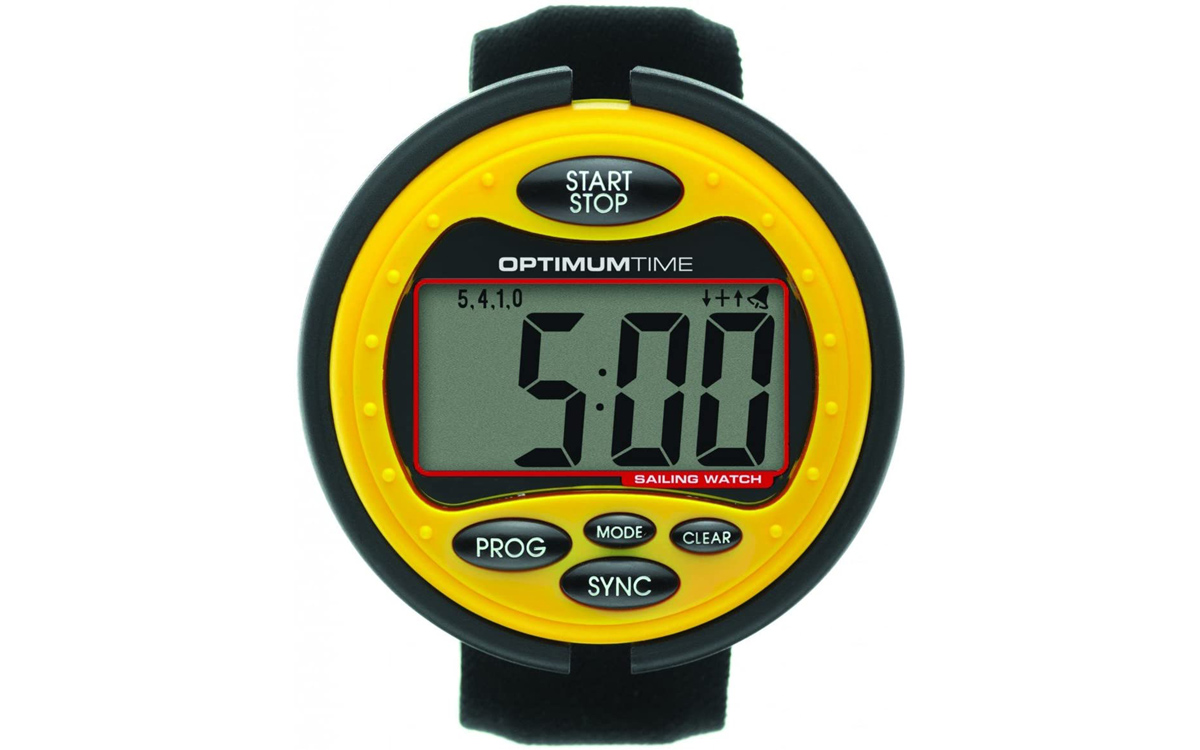
Optimum Time Series 3 sailing watch
Best all-round racing sailing watch
Specifications: Type: Digital | Size: 65mm
Reasons to buy: Great price | Highly functional | Easy to read Reasons to avoid: It’s really big
The popular ‘big yellow’ Optimum Time Series 3 is a lower-priced, yet highly functional racing watch. And it truly is big – far too large for my wrist at a gigantic 65mm (2.56” in) diameter and 16mm (0.62” in) thick. It’s also available in colours other than yellow – including white, blue and pink.
An advantage for racing is that this watch is easy to read at a distance thanks to its huge 16mm digits. A bracket is supplied to fix it to a mast. It also has a sync button if you miss the start gun, and can then run a repeat sequence or race timer for handicap competitions.
Robust, and water resistant to 5 ATM, with a wide elasticated strap.
Buy the Optimum Time Series 3 now on Amazon
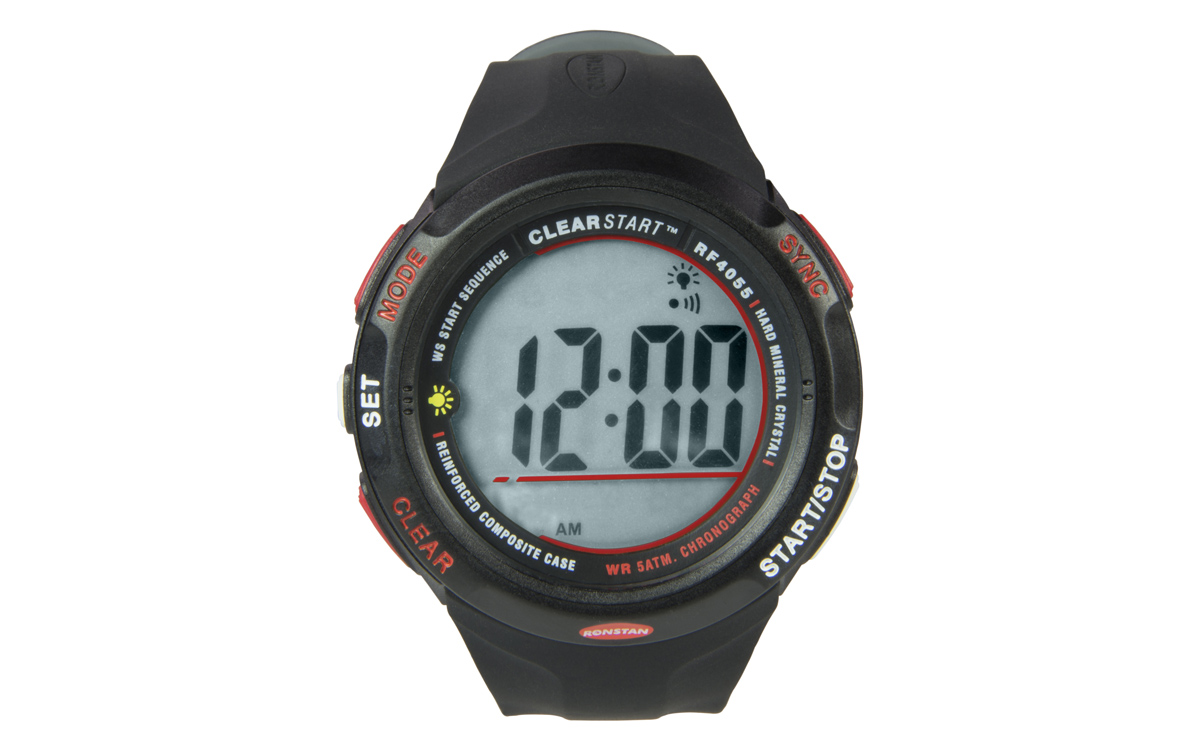
Ronstan Clearstart RF4055 sailing watch
Best specialist racing sailing watch
Specifications: Type: Digital | Size: 50mm
Reasons to buy: Multiple start sequence options | Match racing timer | Can sync for early/late start Reasons to avoid: Larger than average design
This sailing watch is another specialist racing design. Race mode features include multiple start sequence options, match racing timer and the ability to sync for an early or late start.
The Clearstart RF4055 is unusual in that it has a fibreglass case, which is available in striking yellow and red as well as the more subtle black. It has a 50mm (2″) diameter face, which is larger than most watches, with a 13mm (0.5″ in) digital display, and the weight is 74gm (2.61oz), though the buttons have a lower profile than some other race watches making it neater to wear on shore.
Buy the Ronstan Clearstart RF4055 now on Amazon
Buy the Ronstan Clearstart RF4055 now on eBay

Optimum Time Series 12 sailing watch
Best audible racing sailing watch
Specifications: Type: Digital | Size: 26mm
Reasons to buy: Audible warning features | Many colour choices Reasons to avoid: No GPS or interconnectivity | Small display is hard to read in hectic moments
Another race timer with countdown time and pre-programmed start and audible warnings. Despite its more smart watch-style appearance, there is no GPS or interconnectivity, but you do get a countdown repeat option, World Sailing 5-4-1-0 start sequence pre-programmed with audible warning signals, and a sync button.
The Optimum Time Series 12 is available in many colours, but has a small 26mm (1.02” in) display, with 10mm (0.34” in) figures, which will make it hard to read in the middle of a hectic race start.
Buy the Optimum Time Series 12 now on eBay

Gill Race Watch Timer
Best racing sailing watch for watersports
Specifications: Type: Digital | Size 44mm
Reasons to buy: Water-resistant to 30 metres | Carbon housing | The sleep feature preserves battery life Reasons to avoid: Basic design and functions
This striking red and black Race Watch Timer is a sailing-specific watch developed exclusively for watersports apparel company Gill. It’s water-resistant to an impressive 30 metres, with the timepiece unit encased in a reinforced carbon ABS plastic housing with a stainless steel back.
As well as telling the time, the sailing watch’s functions include a countdown with synchro, day, date and alarm. There’s a keyboard lock feature to you don’t accidentally change the settings and an electro-luminescent backlight allows the wearer to check the data day or night.
A neat sleep feature preserves and prolongs battery life in a ruggedly constructed unit designed for durability and years of trouble-free service.

Limit ProXR Countdown sailing watch
Best value racing sailing watch
Reasons to buy: Large, clear, easy to read display | Multiple design options | Dual time, stopwatch, countdown and pacer functions Reasons to avoid: Lacks features/functions of more premium competitors | Chunky
Limit has been producing watches for more than 110 years and specialises in offering a wide variety of styles at great value prices.
For a budget-friendly sailing watch option, the Limit ProXR Countdown comes with a large, clear and easily readable display and is backed by a two-year guarantee.
It also has a dual time display and stopwatch, countdown and pacer functionality. No fewer than five alarms can be set and there’s a night time illumination facility.
Available in a choice of orange/black or blue/black, the looks of this chunky 50 mm case diameter sailing watch certainly belie its low price tag.
Buy the Limit ProXR Countdown now on gooutdoors.co.uk

Ulysse-Nardin The Ocean Race Diver
Specifications: Type: Analogue | Size: 44mm
Reasons to buy: manufacturer with a strong history in watch making | ‘green’ credentials | classy and collectible Reasons to avoid: Lacks features/functions of more sailing-specific watches | you’ll need deep pockets
Swiss watchmaker Ulysse Nardin sourced discarded fishing nets to upcycle into the base material for this watch, highlighting the 640,000 tonnes of nets that are discarded at sea each year.
In addition, 95% of components for the mechanical movement are sourced from within 30km of Ulysse Nardin’s site.
Buy The Ocean Race Diver now on ulysse-nardin.com
FAQ: What makes the best sailing watch?
The ability to read the time, countdown or data in a hurry or at an angle is key, so look out for digital readouts with large numbers – some sailing watches have the ability to switch from digital to analogue readouts – and screens that can be viewed in different qualities of daylight. Backlit functions are essential for anyone heading offshore, whether racing or cruising.
A well-fitting wristband or strap with a secure clasp is vital to keep the watch on your arm. Most sailing watches have soft rubber or synthetic wristbands, which are more durable in a marine environment, and safer than steel. Rubber straps are also lighter and easier to adjust.
If you plan to use your watch for race start timing, look for programmable start sequence options, a sync button, countdowns that switch to seconds in the final stages. A loud, clear alarm or ‘beep’ function that tells you time to the gun is particularly useful, so you can keep watching your course, trim and other boats around you during the final approach to the line rather than having to glance at your wrist.
You can read more about other types of GPS enabled and waterproof fitness trackers and smart watches at YBW.com
Didn’t find what you’re looking for? Head to Amazon’s dedicated boating page for more marine products.

Please verify you are a human
Access to this page has been denied because we believe you are using automation tools to browse the website.
This may happen as a result of the following:
- Javascript is disabled or blocked by an extension (ad blockers for example)
- Your browser does not support cookies
Please make sure that Javascript and cookies are enabled on your browser and that you are not blocking them from loading.
Reference ID: 9a27d2cc-1585-11ef-8ab3-f937faea0f0e
Powered by PerimeterX , Inc.
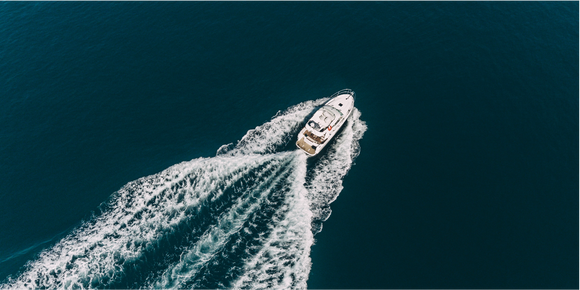
CONVENIENT GAUGE SETS
We offer full sets of matching gauges with either a classic or modern style to quickly and easily dress up the whole console, helm or pilot house look.
![best sailboat instruments Faria Spun Silver Box Set of 4 Gauges f/Outboard Engines - Speedometer, Tach, Voltmeter Fuel Level [KTF0182]](https://marinegaugestore.com/cdn/shop/products/74669XL_{width}x.jpg?v=1614130071)
gauges are all we do
Whether under power or sail, you rely on your boat's instruments to take you out, and bring you home safely and confidently. We've been there, we're boaters, too. When it comes to gauges, don't settle for less. We do gauges. It's all we do. And we only carry the best. So whether pleasure cruising, sailing, fishing, skiing or making a run to the sandbar, you can enjoy the experience knowing you're equipped with the best.
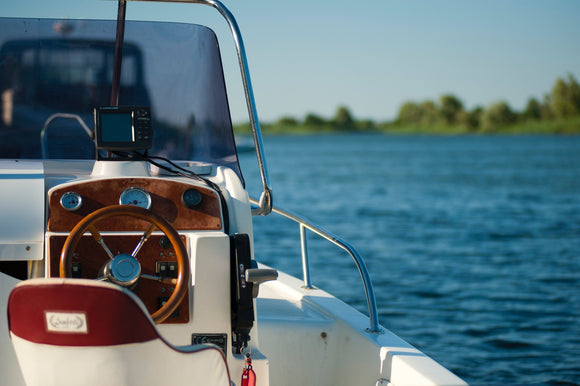
- choosing a selection results in a full page refresh

IMAGES
VIDEO
COMMENTS
The i40 Speed System with through-hull speed transducer goes for $279. Also available from Raymarine are the i50 Digital and i60 Analog Instrument Systems Pack ($1,599). This basic kit is complete with transducers and three instrument displays. An i50 for depth, i50 for speed and an i60 with analog dial for wind.
And the winners are: Editors' Choice: Raymarine Axiom+. Leading Edge Technology: Furuno NavNet TZTouch3 9F. Best Integrated System: Garmin GPSMAP 1243xsv. Most Innovative for Sailing: Airmar DST 810. Best in Entertainment: Rockford Fosgate 12-inch Color Optix M2 Subwoofers.
Sailing instruments are a key part of our boating experience and have been since before the invention of the chronometer. ... Here, our panel of expert cruisers gather some of their best advice on using sailing instrumentation to your advantage. Makeshift mobile phone mast - Pete Goss. Wrap up a mobile to create your own phone mast. Credit ...
A technician runs cables for an electronics upgrade aboard the adaptive sailing catamaran Impossible Dream. Courtesy NMEA/Gemeco Marine Accessories. Contemporary electronics can add a lot to a cruising sailboat. For starters, the gains often include easier-to-understand information, and therefore better situational awareness and increased ...
Garmin's GMI™ 20 digital marine mulifunction instrument is designed for both power and sail vessels. GMI™ 20 clearly shows depth, speed, wind and 100+ marine and vessel parameters. The instruments we described above display one sort of data only. A knotmeter, for example, outputs your speed and distance traveled.
The best sailing electronics for racing are the Airmar DST, Dometic Steering Actuator, and the Garmin Quatix Marine Smartwatch. Other electronics racers can utilize while sailing include the Raymarine Axiom, Garmin GPSMAP, and QWORK Battery Monitor. In my experience, it can be easy to overwhelm yourself with too many electronics.
Whether you're just dipping your toe into sailing or full-on club racing, explore the best electronics for sailing - from navigation to safety equipment. Discover the right sailboat electronics package for any size or type boat, dinghy to keelboat. ... Raymarine instruments are world-renowned for accuracy, innovative features and high ...
High-performance boat instruments with excellent visibility, customizable dashboards, and graphical displays designed to help you make smarter tactical decisions. The Ultimate Sailing Solution Our powerful combination of electronic charting, precision Smart Wind monitoring, and touchscreen tactical displays elevates the awareness of skippers ...
Get in touch for a quote, call our team on +44 (0)1590 718182 - or head to our wind sensor shop to buy parts online. A+T has no connection or affiliation with Navico or B&G. ← A+T IN THE CARIBBEAN. Sailing instruments are hard to get right. They've got to be accurate, durable and easy to read in all kinds of conditions; from blazing sun ...
Sailing Instruments for the Future. The Atlas 2 by Vakaros is the ultimate sailing instrument. Whether you're racing your J/70, Moth, or IC 37, or just out enjoying the water, trust Vakaros to give you the best data to inform every decision on the water.
The essential list of instruments you need on a sailboat includes a depth gauge, speed log, wind instrument, VHF radio, multifunction displays, chart plotter, GPS, AIS, and radar. You can also add display and musical instruments for clarity and entertainment, respectively. In this article, let's look at the significance of instruments on a ...
Vesper Class B AIS Sea Trial. Wind, Speed & Depth Instruments November 11, 2016. During a recent passage from Sarasota, Fla., to Havana, Cuba, Practical Sailor had the chance to compare the new Vesper XB-8000 Class B AIS...
sailing. sailing instruments. CONTACT WEST MARINE. Live Chat. 1-800-262-8464. Store Locator. Shop the best selection of Sailing Instruments from West Marine. Visit for products, prices, deals and more!
B&G's Sailing & Wind Instruments are famous around the world for their durability, accuracy and clarity. Whether you're cruising or racing, the instruments can display speed, depth and wind data among other features you will want to see on our award-winning sailing instrument displays. For 25 years NKE has been developing innovative instrument ...
B&G ® Zeus ® S Wins Boating Industry Magazine's 2023 Top Products Award. See more news and videos. The home of B&G Sailing. The leading manufacturer of Sailing Electronics including Chartplotters, Instruments & Autopilots around the world.
Garmin Quatix 6. Pros: Most popular sports catered for, downloadable upgrades and user modifications, a good Garmin Connect app that allows connection to others using Garmin products, much more ...
Editor's top choices at a glance. Best sailing smart watch - Garmin Quatix 7. Best premium sailing watch - Garmin MARQ Captain. Best value sailing watch - Casio Lithium Quartz. Best racing ...
marine instruments. wind instruments. CONTACT WEST MARINE. Live Chat. 1-800-262-8464. Store Locator. Shop wind sensors and instrument at West Marine including wind transducers, wind meters, displays, interfaces and more. Get free shipping to home or in-store!
5. 6. Marine boat gauges and instruments is all we do. Whether under power or sail, you rely on your boat's instruments to take you out, and bring you home safely and confidently. We only carry the best marine gauges from VDO, Veratron and Faria Beede. Don't settle for less.
For almost 20 years, we've called this awards program SAIL Best Boats, but this year, we're refining and renaming this program to better and more fairly represent the boats we've selected. Restricting boats to categories and labels—such as Best Cruising Monohull 30-40 feet and Best Performance Monohull 40-50 feet—doesn't bring our readers the full picture.
B&G sailing instruments form just one part of a wider system of electronics. To deliver the right data to suit ever sailing need, they can communicate with a range of sensors, processors, and multifunction displays. Connectivity is simple. Our instruments are equipped with the latest NMEA 2000 ® technology to ensure they integrate seamlessly ...